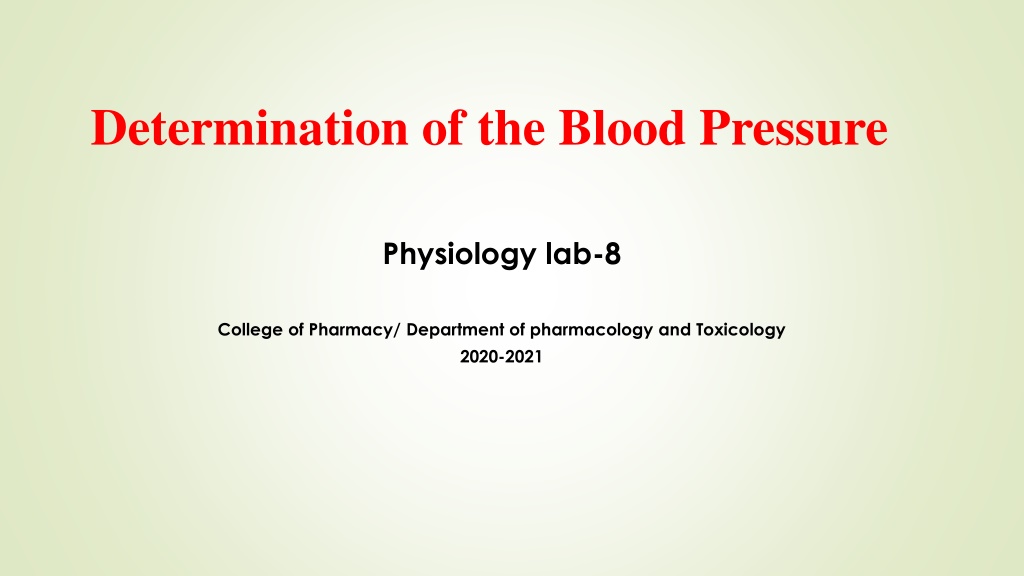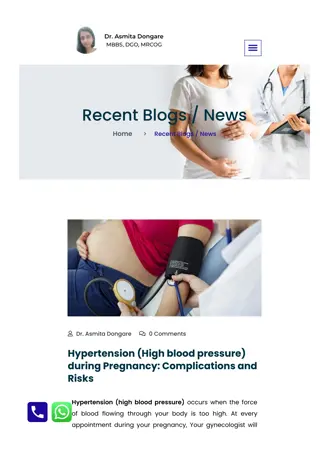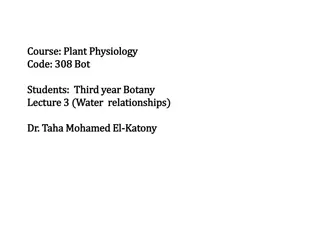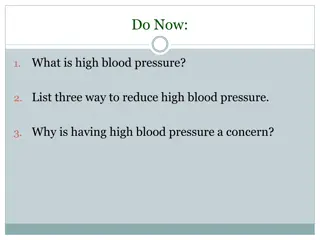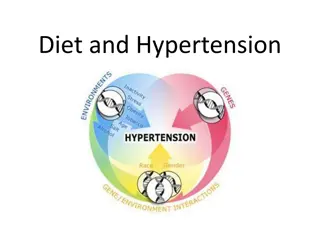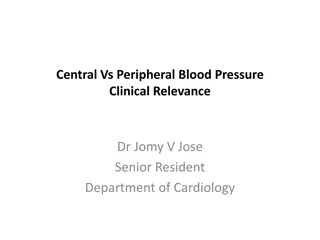Understanding Blood Pressure Physiology in a Lab Setting
Blood pressure (BP) is the lateral pressure exerted by the column of blood on the artery wall. This lab aims to determine BP at rest and after exercise using a sphygmomanometer and stethoscope. Learn about systolic and diastolic pressures, pulse pressure, and mean arterial pressure. Methods include palpatory, auscultatory, and oscillatory approaches. Follow the detailed procedures for each method to accurately measure BP. Gain insights into the importance of these measures in assessing cardiovascular health in this educational setting.
Download Presentation

Please find below an Image/Link to download the presentation.
The content on the website is provided AS IS for your information and personal use only. It may not be sold, licensed, or shared on other websites without obtaining consent from the author. Download presentation by click this link. If you encounter any issues during the download, it is possible that the publisher has removed the file from their server.
E N D
Presentation Transcript
Determination of the Blood Pressure Physiology lab-8 College of Pharmacy/ Department of pharmacology and Toxicology 2020-2021
DEFINITION Blood pressure (BP) is the lateral pressure exerted by the column of blood on the wall of the artery.
Systolic pressure is the maximum pressure in the arteries during systole. It indicates: a. The extent of work done by the heart b. The force with which the heart is working c. The degree of pressure which the arterial walls have to withstand. Diastolic pressure is the minimum pressure at the end of ventricular diastole. It is the measure of constant stretch to which walls of the arteries are subjected. It is more important than systolic pressure because: a. It is less fluctuating b. It is the constant load against which the heart has to work c. It is the pressure of peripheral resistance and depends mainly on the tone of the arteries.
Pulse pressure is the difference between the systolic and diastolic pressures. It is the rise in pressure caused by the ejection of blood into the aorta by ventricular contraction. It is a measure of stroke volume and compliance of arteries. Mean arterial pressure is the average pressure present throughout the cardiac cycle. It is responsible for pushing the blood through the systemic circulatory system. It is equal to diastolic pressure + 1/3 pulse pressure
Blood Pressure Determinations AIM To determine the blood pressure of the given subject at rest and after moderate exercise. APPARATUS Sphygmomanometer and stethoscope. PRINCIPLE The pressure of blood in the artery (brachial artery) is balanced against the pressure of air in a rubber cuff surrounding the artery. The pressure of air in the cuff is then measured by means of a mercury manometer.
METHODS: 1. Palpatory method 2. Auscultatory method 3. Oscillatory method.
Procedure Palpatory method: The subject is asked to sit on a stool. The cuff is tied around the upper arm with the lower border of the cuff not less than 2.5 cm above the cubital fossa. The outlet valve of the bulb is closed. The radial pulse is palpated while the cuff is being inflated to a pressure slightly above the level at which the radial pulsation is no longer felt. The pressure at which the pulsation was obliterated is read in the mercury manometer. The outlet valve is opened. The manometric reading is noted at the point where the pulsation reappears. The average of the two readings gives the systolic pressure. The diastolic pressure cannot be determined by this method.
procedure Auscultatory method: By palpatory method, only the systolic blood pressure could be measured. By auscultatory method, both the systolic and diastolic blood pressure can be measured. The chest piece of the stethoscope is placed over the brachial artery.The pressure in the cuff is raised above the systolic pressure (by about 30 mm Hg) previously determined by the palpatory method. The pressure is then lowered gradually (2 3 mm per second). The sounds that are heard are the Korotkoff s sounds. The first sound (phase one) that occurs is a sharp tapping sound, indicates the peak systolic pressure, the second and third phases, initially murmurs in quality and then louder and more banging, are due to turbulent flow of blood through a partially occluded vessel. In the fourth phase, the sound becomes muffled and dull and the fifth phase accurately gives true diastolic pressure, which is disappearance of the sound (Figure 1).
C D Systolic Bp A Diastolic Bp B Figs 1: (A) Mercury sphygmomanometer; (B) Aneroid sphygmomanometer; (C) Riva-Rocci cuff; (D) Korotokoff s sounds
procedure Oscillatory method: This is another method of determining blood pressure. By this method, both the systolic and diastolic blood pressure are determined. The pressure at which oscillations appear in the mercury manometer gives the systolic pressure and the pressure at which it disappears give the diastolic blood pressure. However, this method is not accurate.
Important precautions in the use of sphygmomanometer: 1. The manometer should be placed at the level of the heart. 2. The lower border of the cuff should be 2.5 cm above the cubital fossa. For children, a narrow cuff should be used. 3. Blood pressure should be preferably taken in the left arm
NORMAL VALUES The average systolic pressure in healthy adults is 100 140 mm Hg. The average diastolic pressure is 60 90 mm Hg. In children it is closer to the lower end of the scale and in the elderly, it reaches or even exceeds the higher figure. The difference between the systolic and diastolic pressure is the pulse pressure 40 60 mm Hg.
Observing the Effect of Various Factors on Blood Pressure and Heart Rate Arterial blood pressure is directly proportional to cardiac output (CO, amount of blood pumped out of the left ventricle per unit time) and peripheral resistance (PR) to blood flow, that is, BP = CO * PR Peripheral resistance is increased by blood vessel constriction (most importantly the arterioles), by an increase in blood viscosity, and by a loss of elasticity of the arteries (seen in arteriosclerosis). Any factor that increases either the cardiac output or the peripheral resistance causes an almost immediate reflex rise in blood pressure.
Physiological Variations 1. Blood pressure is slightly lower in women than men. 2. Persons with slender build have got a lower blood pressure than those of heavy build. 3. During sleep, systolic pressure is less. 4. Emotional excitement and muscular exercise cause an increase in the blood pressure. It is also increased after meals. 5. The blood pressure especially the diastolic is highest in the standing position, lower in the sitting and lowest while the subject is lying down.
Effect of moderate exercise on blood pressure During exercise, there is a moderate increase in systolic blood pressure. This is due to an increase in cardiac output caused by an increased heart rate and myocardial contractility (stroke volume increases) due to increased sympathetic activity, and increased venous return. The effects of vasoconstriction in inactive regions are overcome by vasodilatation in active muscles. Hence, the diastolic pressure at the pre-exercise level is slightly reduced. Pulse pressure is increased.
The Pulse The term pulse refers to the alternating flows of pressure (expansion and then recoil) in an artery that occur with each contraction and relaxation of the left ventricle. Normally the pulse rate (or the count of arterial pulse per minute) equals the heart rate (beats per minute), and the pulse averages 70 to 76 beats per minute in the resting state. The pulse may be felt easily on any superficial artery when the artery is compressed over a bone or firm tissue such as at the neck (carotid artery), on the inside of the elbow (brachial artery), at the wrist (radial artery).
